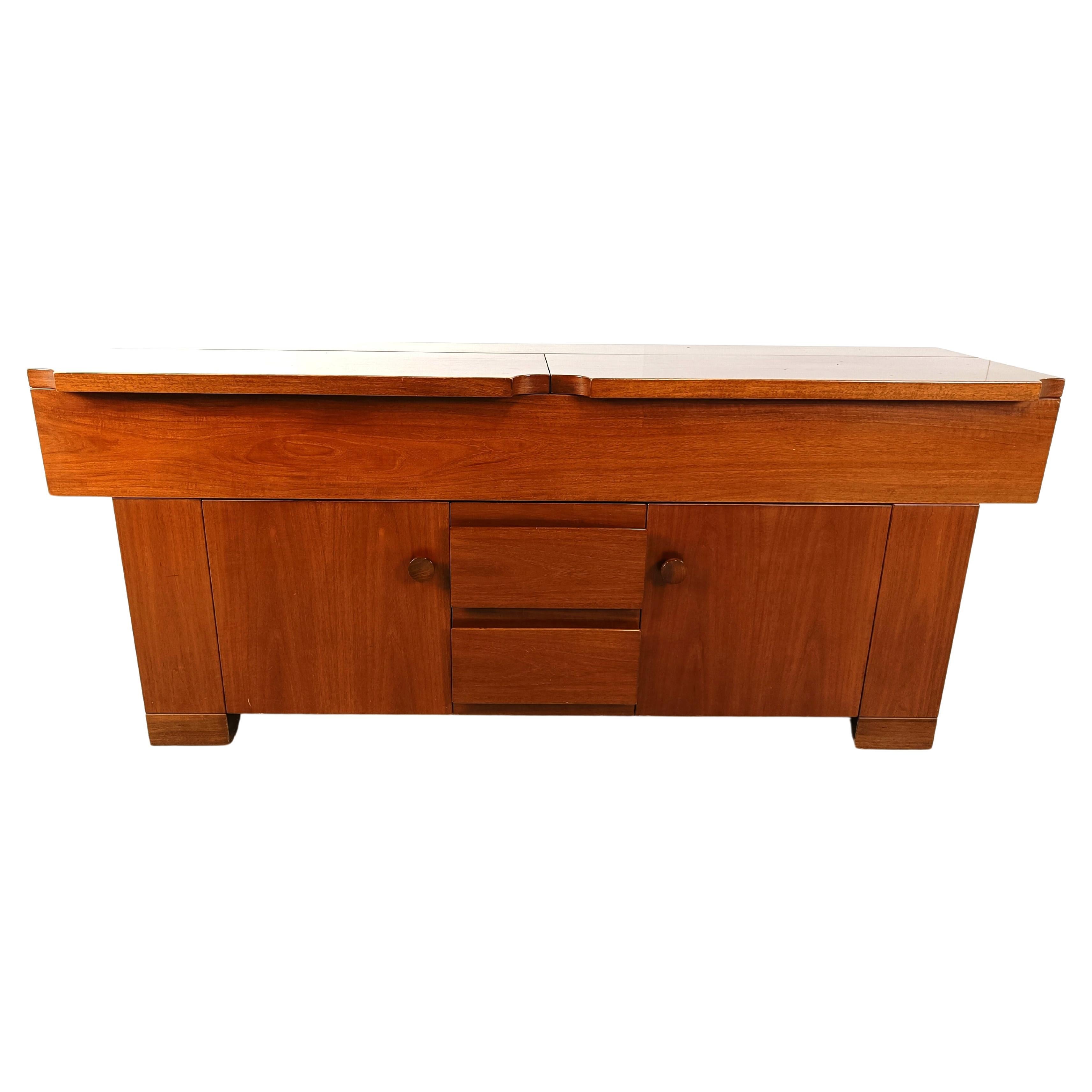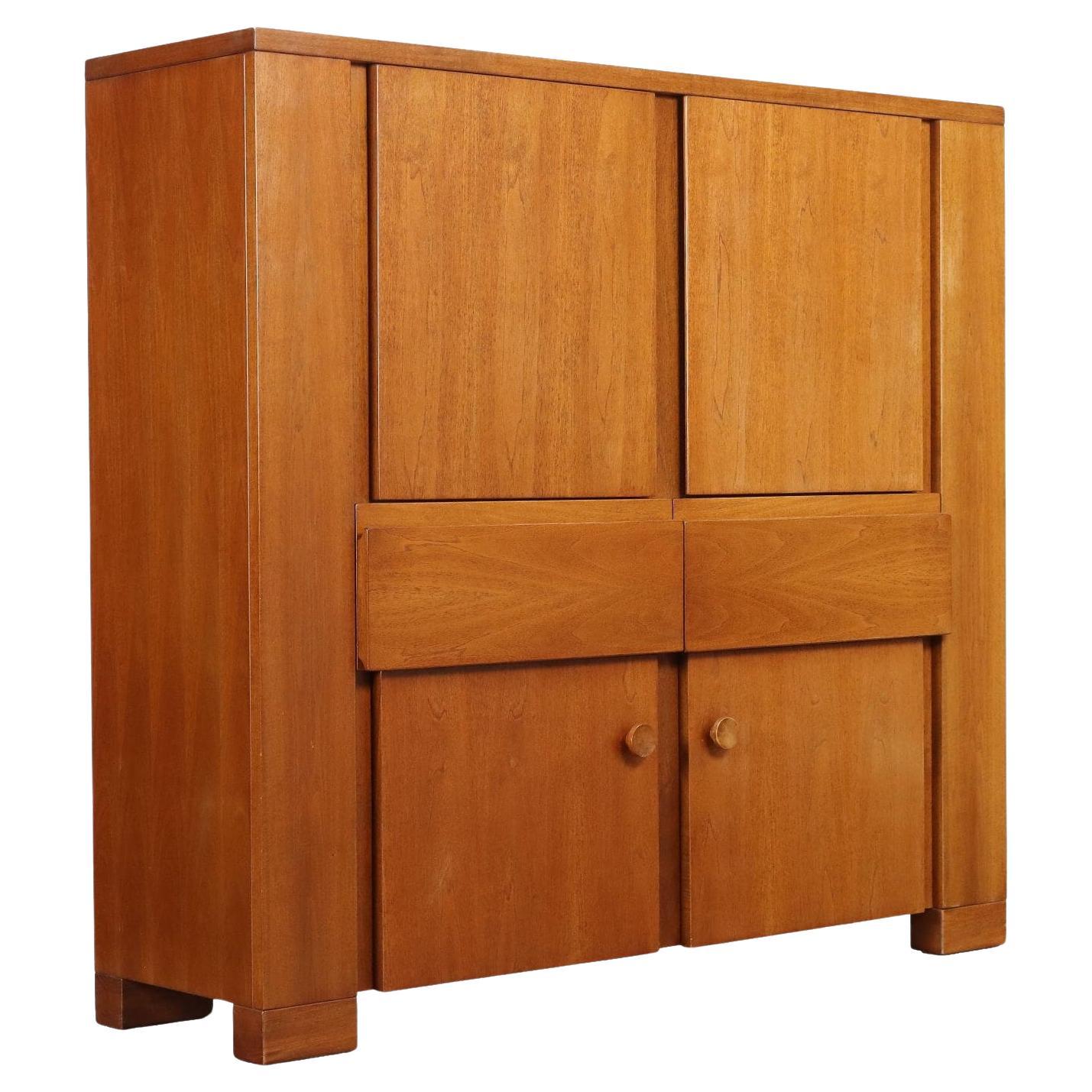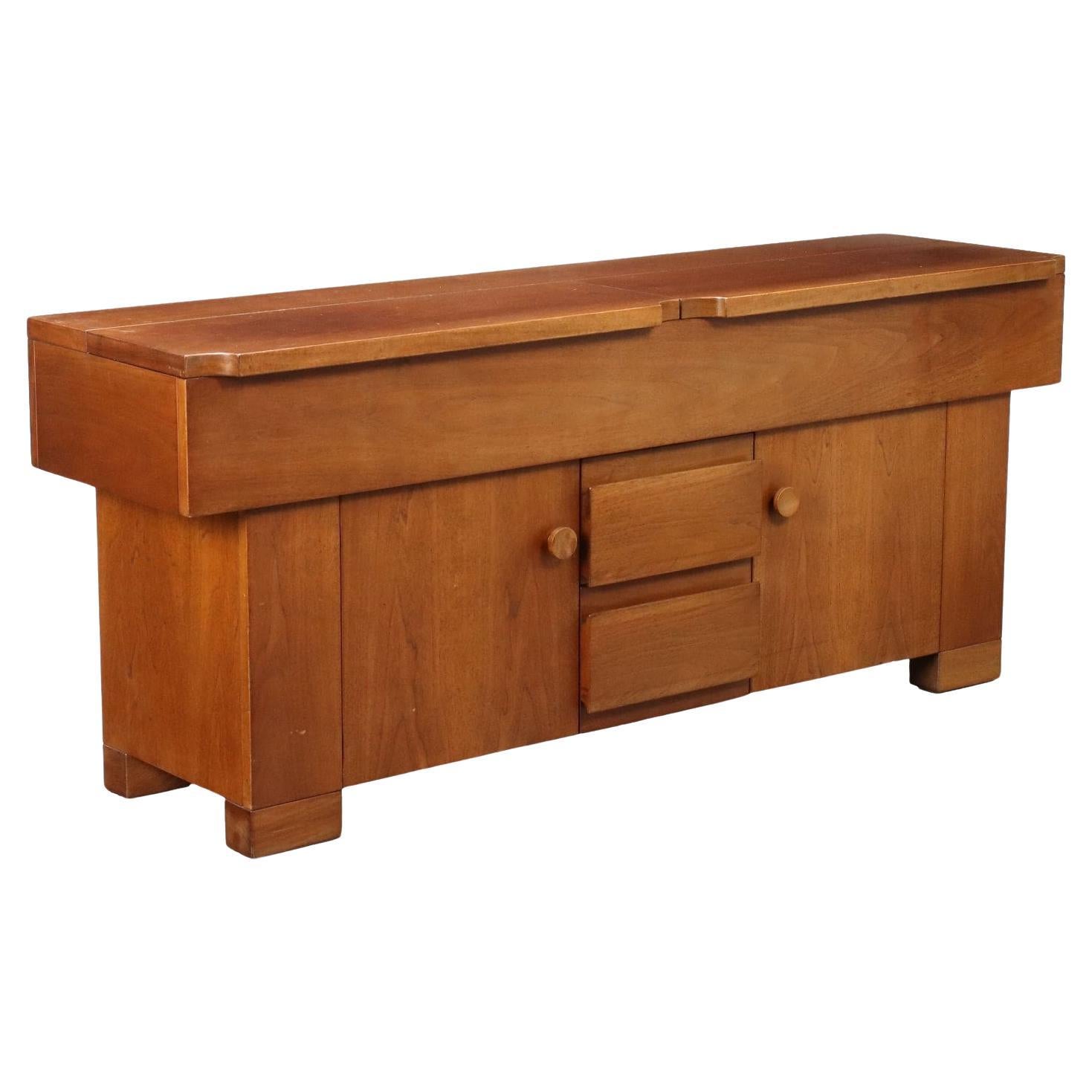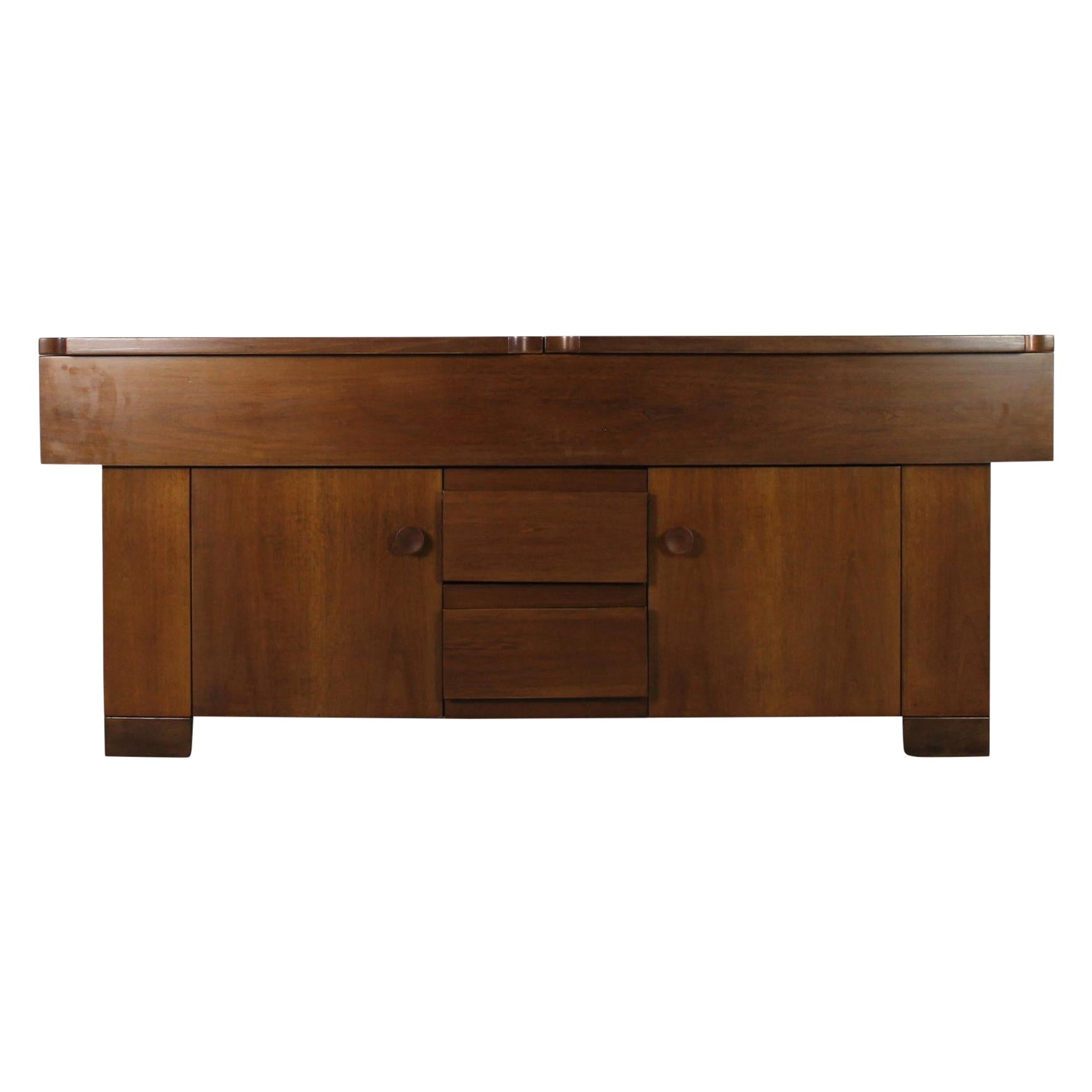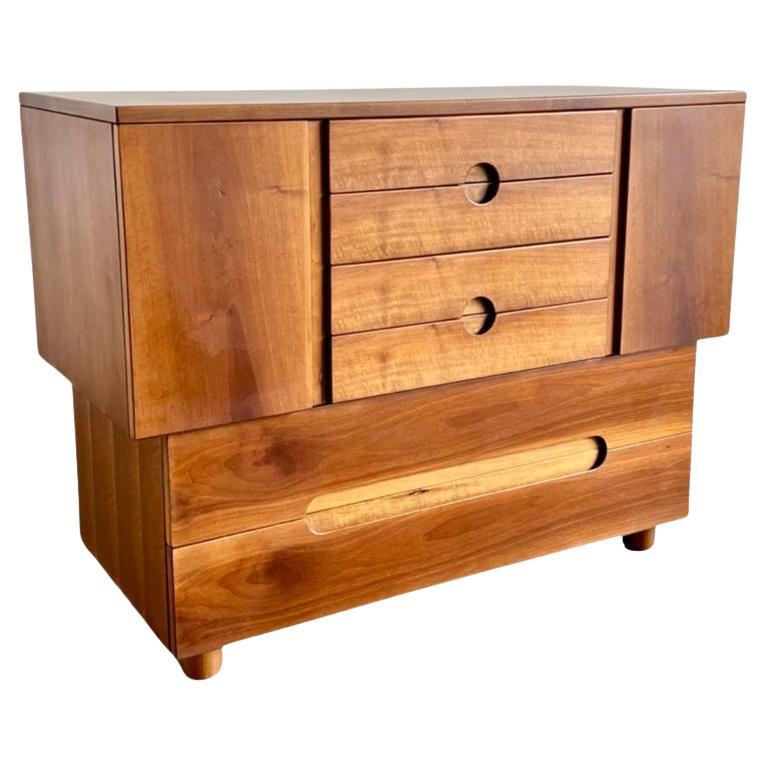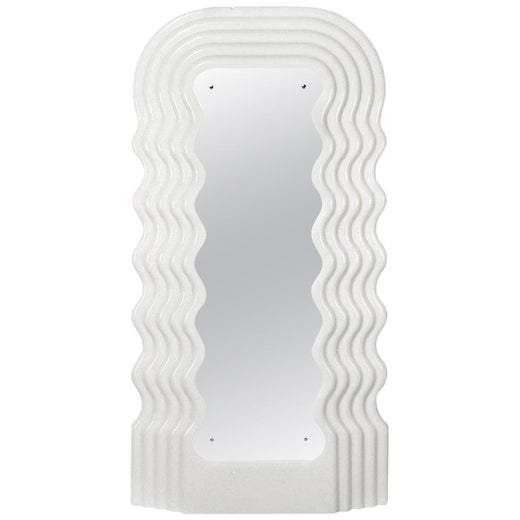Poltronova Sideboard in the Style of Torbecchia by Giovanni Michelucci, 1970s
About the Item
- Creator:Poltronova (Manufacturer)
- Similar to:Giovanni Michelucci (Designer)
- Dimensions:Height: 33.86 in (86 cm)Width: 78.75 in (200 cm)Depth: 21.26 in (54 cm)
- Style:Mid-Century Modern (Of the Period)
- Materials and Techniques:
- Place of Origin:
- Period:
- Date of Manufacture:1970
- Condition:Wear consistent with age and use.
- Seller Location:Vicenza, IT
- Reference Number:1stDibs: LU8019235916192
Poltronova
Poltronova is known for embracing the creativity that opposites can introduce to a space. Its radical modernist furniture and lighting fixtures are simultaneously grounded in classic aesthetics and inspired by what were then new and provocative artistic movements in mid-century Italy, when the company was founded. This tension resulted in unique and extraordinary pieces at the manufacturer, from eccentric, glove-shaped armchairs to striking dining tables that feature a mix of materials and textures.
Italian designer Sergio Cammilli founded Poltronova in Tuscany in 1957. That same year, it won the Compasso d’Oro for the Panchetto chair designed by Luciano Nustrini. Revolutionary Italian architect Ettore Sottsass — a maestro of postmodern design who would later establish the Memphis Group — came on board as an art director in 1958. Poltronova manufactured many of his furniture and ceramic designs. Sottsass’s lighting, seating and other works for Poltronova showcase the designer’s bold experimentation with solid wood, glass, metal and laminate materials.
Other established names in Italian furniture design collaborated with Poltronova’s Sottsass and Cammilli, including Giovanni Michelucci, Gae Aulenti and Angelo Mangiarotti. However, the company truly set itself apart in its collaborations with Superstudio and Archizoom Associati, groups that were part of an irreverent, avant-garde movement in art and design that took shape during the 1960s in Florence, Turin and Milan. Collectives associated with the movement — which would one day be called Italian Radical design — drew on Pop art and minimalism and explored working with unconventional materials to create colorful, quirky and uniquely shaped objects and furnishings. At the time, Poltronova also worked with up-and-coming names in the art world, like painter Max Ernst and sculptor Mario Ceroli.
Poltronova showcased its groundbreaking designs in many exhibitions, such as “La Casa Abitata,” which was held in Florence in 1965. At Milan's Eurodomus trade show in 1970, Poltronova debuted an entire bedroom collection designed by Sottsass — including his sensuous Ultrafragola mirror. The brand’s furnishings were included in a 1972 exhibition at New York’s Museum of Modern Art called "Italy: The New Domestic Landscape," and in 1977, Poltronova again won the Compasso d’Oro for a book called Fare Mobili con Poltronova (Making Furniture with Poltronova).
Poltronova's enduring and acclaimed furniture designs came to be loved far outside Italy. During the 1960s, importer Charles Stendig represented the company and helped introduce it to the American market.
In 2005, Poltronova established the Centro Studi Poltronova to recreate some of the company's iconic furniture. The brand has also recently collaborated with English architect Nigel Coates, who worked with a Poltronova master craftsman in Italy to design a series of limited-edition furniture in 2011, including the Domo chair.
On 1stDibs, find vintage Poltronova tables, seating, storage cabinets and more.
- ShippingRetrieving quote...Ships From: Vicenza, Italy
- Return PolicyA return for this item may be initiated within 14 days of delivery.
- Ettore Sottsass Walnut Rocchetto Side Table for Poltronova, 1964, Set of 2By Poltronova, Ettore SottsassLocated in Vicenza, ITPair of Rocchetto side tables, designed by Ettore Sottsass and manufactured by Poltronova in 1964. Made of lacquered walnut wood. Excellent vintage condition. Ettore Sottsass Jr., a...Category
Vintage 1960s Italian Mid-Century Modern Side Tables
MaterialsWalnut
- Studio Simon Granite Brutalist Samo Table in the Style of Carlo Scarpa, 1970By Studio Simon, Carlo ScarpaLocated in Vicenza, ITDining table mod. ‘Samo’ by Studio Simon. Series ‘Ultrarazionale’. Italy, 1970. Made of granite. Literature: Giuliana Gramigna, Repertorio 1950-2000, Allemandi, Torino, 2003, p.180. Excellent vintage condition. The Samo table was designed in 1970 by the project office of Studio Simon. Carlo Scarpa was the brand's artistic director, and the Venetian architect's style inspired the shapes of this table. Born in Venice on June 2nd, 1906, Carlo Scarpa began working at a very early age. Only a year after he had first qualified as an architect in 1926, he began working for the Murano glassmakers Cappellin & Co. in a consultative capacity; from 1927, he began to experiment with the Murano glass, and this research not only gave him excellent results here but would also inform his progress for many years to come. Between 1935 and 1937, as he entered his thirties, Carlo Scarpa accepted his first important commission, the renovation of Venice’s Cà Foscari. He adapted the spaces of this stately University building which stands on the banks of the Grand Canal, creating rooms for the Dean’s offices and a new hall for academic ceremonies; Mario Sironi and Mario De Luigi were charged with doing the restoration work on the frescos. After 1945, Carlo Scarpa found himself constantly busy with new commissions, including various furnishings and designs for the renovation of Venice’s Hotel Bauer and designing a tall building in Padua and a residential area in Feltre, which are all worth mention. One of his key works, despite its relatively modest diminished proportions, was the first of many works which were to follow in the nineteen fifties: the [bookshop known as the] Padiglione del Libro, which stands in Venice’s Giardini di Castello and shows clearly Scarpa’s passion for the works of Frank Lloyd Wright. In the years which were to follow, after he had met the American architect, Scarpa repeated similar experiments on other occasions, as can be seen, in particular, in the sketches he drew up in 1953 for villa Zoppas in Conegliano, which show some of his most promising work. However, this work unfortunately never came to fruition. Carlo Scarpa later created three museum layouts to prove pivotal in terms of how 20th century museums were to be set up from then on. Between 1955 and 1957, he completed extension work on Treviso’s Gipsoteca Canoviana [the museum that houses Canova’s sculptures] in Possagno, taking a similar experimental approach to the one he used for the Venezuelan Pavilion at [Venice’s] Giardini di Castello which he was building at the same time (1954-56). In Possagno Carlo Scarpa was to create one of his greatest ever works, which inevitably bears comparison with two other museum layouts that he was working on over the same period, those of the Galleria Nazionale di Sicilia, housed in the Palazzo Abatellis in Palermo (1953-55) and at the Castelvecchio in Verona (1957- 1974), all of which were highly acclaimed, adding to his growing fame. Two other buildings, which are beautifully arranged in spatial terms, can be added to this long list of key works that were started and, in some cases, even completed during the nineteen fifties. After winning the Olivetti award for architecture in 1956, Scarpa began work in Venice’s Piazza San Marco on an area destined to house products made by the Industrial manufacturers Ivrea. Over the same period (1959-1963), he also worked on renovation and restoration of the gardens and ground floor of the Fondazione Querini Stampalia in Venice, which many consider being one of his greatest works. While he busied himself working on-site at the Fondazione Querini Stampalia, Carlo Scarpa also began work building a villa in Udine for the Veritti family. To shed some light on the extent to which his work evolved over the years, it may perhaps be useful to compare this work with that of his very last building, villa Ottolenghi Bardolino, which was near to completion at the time of his sudden death in 1978. Upon completion of villa Veritti over the next ten years, without ever letting up on his work on renovation and layouts, Scarpa accepted some highly challenging commissions which were to make the most of his formal skills, working on the Carlo Felice Theatre in Genoa as well as another theatre in Vicenza. Towards the end of this decade, in 1969, Rina Brion commissioned Carlo Scarpa to build the Brion Mausoleum in San Vito d’Altivole (Treviso), a piece he continued to work on right up until the moment of his death. Nevertheless, even though he was totally absorbed by work on this mausoleum, there are plenty of other episodes which can offer some insight into the final years of his career. As work on the San Vito d’Altivole Mausoleum began to lessen from 1973, Carlo Scarpa began work building the new headquarters for the Banca Popolare di Verona. He drew up plans that were surprisingly different from the work he was carrying out at the same time on the villa Ottolenghi. However, the plans Carlo Scarpa drew up, at different times, for a monument in Brescia’s Piazza della Loggia commemorating victims of the terrorist attack on May 28th, 1974, make a sharp contrast to the work he carried out in Verona, almost as if there is a certain hesitation after so many mannered excesses. The same Pietas that informs his designs for the Piazza Della Loggia can also be seen in the presence of the water that flows through the Brion Mausoleum, almost as if to give a concrete manifestation of pity in this 20th century work of art. Carlo Scarpa has put together a highly sophisticated collection of structures, occupying the mausoleum’s L-shaped space stretching across both sides of the old San Vito d’Altivole cemetery. A myriad of different forms and an equally large number of different pieces, all of which are separate and yet inextricably linked to form a chain that seems to offer no promise of continuity, rising up out of these are those whose only justification for being there is to bear the warning “si vis vitam, para mortem”, [if you wish to experience life prepare for death] as if to tell a tale that suggests the circle of time, joining together the commemoration of the dead with a celebration of life. At the entrance of the Brion Mausoleum stand the “propylaea” followed by a cloister which ends by a small chapel, with an arcosolium bearing the family sarcophagi, the main pavilion, held in place on broken cast iron supports, stands over a mirror-shaped stretch of water and occupies one end of the family’s burial space. The musical sound of the walkways teamed with the luminosity of these harmoniously blended spaces shows how, in keeping with his strong sense of vision, Carlo Scarpa could make the most of all of his many skills to come up with this truly magnificent space. As well as a great commitment to architectural work, with the many projects which we have already seen punctuating his career, Carlo Scarpa also made many equally important forays into the world of applied arts. Between 1926 and 1931, he worked for the Murano glassmakers Cappellin, later taking what he had learned with him when he went to work for the glassmakers Venini from 1933 until the 1950s. The story of how he came to work on furniture design is different, however, and began with the furniture he designed to replace lost furnishings during his renovation of Cà Foscari. The later mass-produced furniture started differently, given that many pieces were originally one-off designs “made to measure”. Industrial manufacturing using these designs as prototypes came into being thanks to the continuity afforded him by Dino Gavina, who, as well as this, also invited Carlo Scarpa to become president of the company Gavina SpA, later to become SIMON, a company Gavina founded 8 years on, in partnership with Maria Simoncini (whose own name accounts for the choice of company name). Carlo Scarpa and Gavina forged a strong bond in 1968 as they began to put various models of his into production for Simon, such as the “Doge” table, which also formed the basis for the “Sarpi” and “Florian” tables. In the early seventies, other tables that followed included “Valmarana”, “Quatour” and “Orseolo”. While in 1974, they added couch and armchair “Cornaro” to the collection and the “Toledo” bed...Category
Vintage 1970s Italian Mid-Century Modern Dining Room Tables
MaterialsGranite
- Italian Design Coffee Table in The Style of Alanda by Paolo Piva, 1980sBy B&B Italia, Paolo PivaLocated in Vicenza, ITCoffee table in the style of Alanda by Paolo Piva for B&B Italia. Step into the world of timeless elegance with the Alanda Coffee Table, a celebrated artifact that heralded the 80s ...Category
Vintage 1980s Italian Industrial Coffee and Cocktail Tables
MaterialsSteel
- Set of 6 Midcentury Italian Walnut and Leather Dining Chairs, 1970sBy Afra & Tobia Scarpa, GavinaLocated in Vicenza, ITThis set of six dining chairs was designed and manufactured in Italy during the 1970s, showcasing a walnut structure and leather seaters. These chairs remain in excellent vintage co...Category
Vintage 1970s Italian Mid-Century Modern Chairs
MaterialsLeather, Walnut
- Mario Marenco Walnut Sapporo Dining Chairs for Mobilgirgi, 1970s, Set of 4By Mario Marenco, Mobil GirgiLocated in Vicenza, ITSet of four “Sapporo” dining chairs, designed by Mario Marenco and produced by the Italian manufacturer Mobilgirgi in the 1970s. They feature a ...Category
Vintage 1970s Italian Mid-Century Modern Chairs
MaterialsLeather, Walnut
- Midcentury Modern Italian Design Beech & Leather Dining Chairs, 1970s, Set of 4By Artek, Alvar AaltoLocated in Vicenza, ITSet of four Italian dining chairs, made in the 70s. They feature a beech wood structure and a brown woven leather seat. The s-shaped backrest, linked with the squared legs, is the ma...Category
Vintage 1970s Italian Scandinavian Modern Dining Room Chairs
MaterialsLeather, Beech
- Torbecchia Sideboard by Giovanni Michelucci for Poltronova, 1960sBy Poltronova, Giovanni MichelucciLocated in HEVERLEE, BERare mid century sideboard designed by Giovanni Michelucci for Poltronova model 'torbecchia'. this walnut sideboard has two unique folding tops, 2 regular doors and 2 central drawe...Category
Vintage 1960s Italian Mid-Century Modern Credenzas
MaterialsWalnut
- Sideboard 'Torbecchia' by Giovanni Michelucci for Poltronova Anni 60-70By Poltronova, Giovanni MichelucciLocated in Milano, ITSideboard cabinet with hinged doors and exposed drawers, designed by Michelucci in 1964; walnut veneer wood. Good ConditionCategory
Vintage 1960s Italian Mid-Century Modern Credenzas
MaterialsWalnut
- 'Torbecchia' cabinet by Giovanni Michelucci for Poltronova 1960s-70sBy Poltronova, Giovanni MichelucciLocated in Milano, ITSideboard cabinet with hinged doors and exposed drawers, designed by Michelucci in 1964; walnut veneer wood. Good conditions.Category
Vintage 1960s Italian Mid-Century Modern Credenzas
MaterialsNutwood
- Giovanni Michelucci Torbecchia Sideboard in Walnut Wood by Poltronova 1964By Poltronova, Giovanni MichelucciLocated in Montecatini Terme, ITTorbecchia sideboard is entirely realized in solid veneered walnut wood, with two frontal hinging doors (inner shelves), two drawers, and a storage unit under the openable top part. ...Category
Vintage 1960s Italian Mid-Century Modern Sideboards
MaterialsWalnut, Wood
- Giovanni Michelucci Serena Chest of Drawers for Poltronova, 1955By Poltronova, Giovanni MichelucciLocated in Byron Bay, NSWGorgeous and rare "Serena "chest of drawers mod. Serena in walnut wood, designed by Giovanni Michelucci for Poltronova, 1955, Italy. Signed piece.Category
Vintage 1950s Italian Mid-Century Modern Commodes and Chests of Drawers
MaterialsWalnut
- Giovanni Michelucci Poltronova Italian Midcentury Walnut Chest of Drawers 1960sBy Poltronova, Giovanni MichelucciLocated in Reggio Emilia, ITWalnut chest of drawers from the "Serena CSM 98" series designed by Giovanni Michelucci and manufactured by Poltronova, production Italy 1964. G. Michelucci stamped mark. The chest ...Category
Vintage 1960s Italian Mid-Century Modern Commodes and Chests of Drawers
MaterialsNutwood
